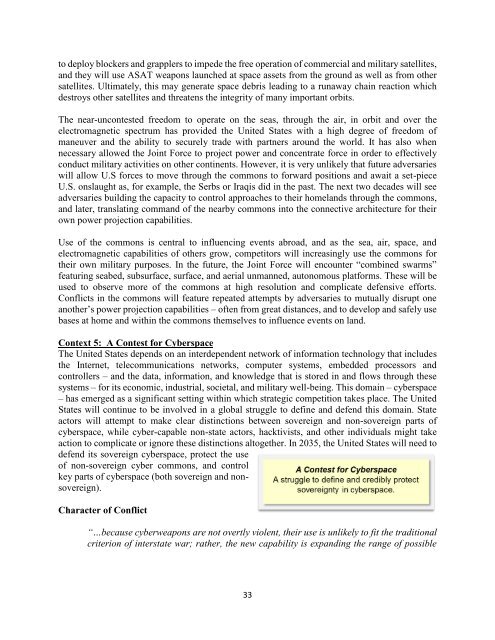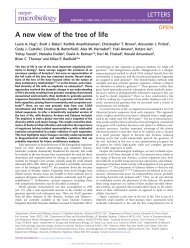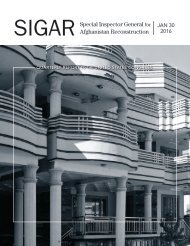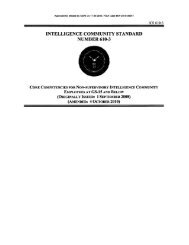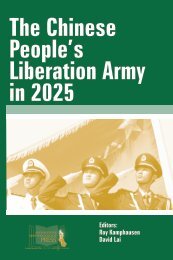The Joint Force in a Contested and Disordered World
JCS-JOE-2035
JCS-JOE-2035
Create successful ePaper yourself
Turn your PDF publications into a flip-book with our unique Google optimized e-Paper software.
to deploy blockers <strong>and</strong> grapplers to impede the free operation of commercial <strong>and</strong> military satellites,<br />
<strong>and</strong> they will use ASAT weapons launched at space assets from the ground as well as from other<br />
satellites. Ultimately, this may generate space debris lead<strong>in</strong>g to a runaway cha<strong>in</strong> reaction which<br />
destroys other satellites <strong>and</strong> threatens the <strong>in</strong>tegrity of many important orbits.<br />
<strong>The</strong> near-uncontested freedom to operate on the seas, through the air, <strong>in</strong> orbit <strong>and</strong> over the<br />
electromagnetic spectrum has provided the United States with a high degree of freedom of<br />
maneuver <strong>and</strong> the ability to securely trade with partners around the world. It has also when<br />
necessary allowed the <strong>Jo<strong>in</strong>t</strong> <strong>Force</strong> to project power <strong>and</strong> concentrate force <strong>in</strong> order to effectively<br />
conduct military activities on other cont<strong>in</strong>ents. However, it is very unlikely that future adversaries<br />
will allow U.S forces to move through the commons to forward positions <strong>and</strong> await a set-piece<br />
U.S. onslaught as, for example, the Serbs or Iraqis did <strong>in</strong> the past. <strong>The</strong> next two decades will see<br />
adversaries build<strong>in</strong>g the capacity to control approaches to their homel<strong>and</strong>s through the commons,<br />
<strong>and</strong> later, translat<strong>in</strong>g comm<strong>and</strong> of the nearby commons <strong>in</strong>to the connective architecture for their<br />
own power projection capabilities.<br />
Use of the commons is central to <strong>in</strong>fluenc<strong>in</strong>g events abroad, <strong>and</strong> as the sea, air, space, <strong>and</strong><br />
electromagnetic capabilities of others grow, competitors will <strong>in</strong>creas<strong>in</strong>gly use the commons for<br />
their own military purposes. In the future, the <strong>Jo<strong>in</strong>t</strong> <strong>Force</strong> will encounter “comb<strong>in</strong>ed swarms”<br />
featur<strong>in</strong>g seabed, subsurface, surface, <strong>and</strong> aerial unmanned, autonomous platforms. <strong>The</strong>se will be<br />
used to observe more of the commons at high resolution <strong>and</strong> complicate defensive efforts.<br />
Conflicts <strong>in</strong> the commons will feature repeated attempts by adversaries to mutually disrupt one<br />
another’s power projection capabilities – often from great distances, <strong>and</strong> to develop <strong>and</strong> safely use<br />
bases at home <strong>and</strong> with<strong>in</strong> the commons themselves to <strong>in</strong>fluence events on l<strong>and</strong>.<br />
Context 5: A Contest for Cyberspace<br />
<strong>The</strong> United States depends on an <strong>in</strong>terdependent network of <strong>in</strong>formation technology that <strong>in</strong>cludes<br />
the Internet, telecommunications networks, computer systems, embedded processors <strong>and</strong><br />
controllers – <strong>and</strong> the data, <strong>in</strong>formation, <strong>and</strong> knowledge that is stored <strong>in</strong> <strong>and</strong> flows through these<br />
systems – for its economic, <strong>in</strong>dustrial, societal, <strong>and</strong> military well-be<strong>in</strong>g. This doma<strong>in</strong> – cyberspace<br />
– has emerged as a significant sett<strong>in</strong>g with<strong>in</strong> which strategic competition takes place. <strong>The</strong> United<br />
States will cont<strong>in</strong>ue to be <strong>in</strong>volved <strong>in</strong> a global struggle to def<strong>in</strong>e <strong>and</strong> defend this doma<strong>in</strong>. State<br />
actors will attempt to make clear dist<strong>in</strong>ctions between sovereign <strong>and</strong> non-sovereign parts of<br />
cyberspace, while cyber-capable non-state actors, hacktivists, <strong>and</strong> other <strong>in</strong>dividuals might take<br />
action to complicate or ignore these dist<strong>in</strong>ctions altogether. In 2035, the United States will need to<br />
defend its sovereign cyberspace, protect the use<br />
of non-sovereign cyber commons, <strong>and</strong> control<br />
key parts of cyberspace (both sovereign <strong>and</strong> nonsovereign).<br />
Character of Conflict<br />
“…because cyberweapons are not overtly violent, their use is unlikely to fit the traditional<br />
criterion of <strong>in</strong>terstate war; rather, the new capability is exp<strong>and</strong><strong>in</strong>g the range of possible<br />
33


